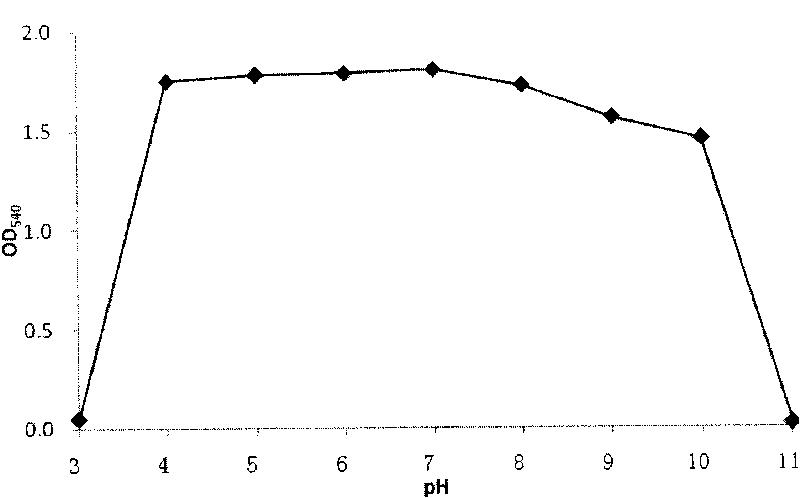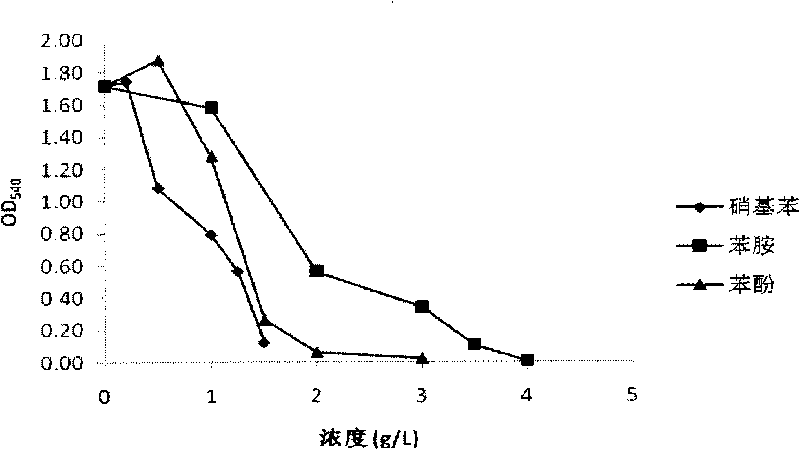Method for culturing microbial strain for degrading industrial waste water
A technology for the degradation and cultivation of industrial wastewater, applied in the direction of biochemical equipment and methods, microorganisms, microorganisms, etc., can solve the problems of no degradation ability, etc., and achieve the effect of convenient application, wide range and high degradation efficiency
- Summary
- Abstract
- Description
- Claims
- Application Information
AI Technical Summary
Problems solved by technology
Method used
Image
Examples
Embodiment 1
[0034]Aiming at the aniline, phenol and nitrobenzene compounds in industrial wastewater, the concentration of 0g / L, 0.5g / L, 1.0g / L, 1.5g / L, 2.0g / L, 2.5g / L, 3.0 g / L, 3.5g / L target compound aniline, phenol and nitrobenzene compound liquid medium with different concentration gradients, in which aniline and nitrobenzene compound use it as the only carbon source and nitrogen source, and phenol adds nitrogen in addition Source peptone 1000mg / L, also add other chemical substrate formula potassium nitrate needed for microbial strain growth in the described liquid culture medium: 0.5g / L; Sodium chloride: 1g / L; K 2 HPO 4 ·3H 2 O: 0.8g / L; MgSO 4 ·7H 2 O: 0.2g / L; FeSO 4 ·7H 2 O 0.010g / L, and add part of the liquid medium to add 15g agar (calculated according to 1000ml water) and convert it into a selective solid medium.
[0035] The activated sludge in the industrial wastewater is added to the conventional beef extract peptone liquid medium for enrichment, and then inoculated to the...
Embodiment 2
[0039] Aiming at the aniline, phenol and nitrobenzene compounds in industrial wastewater, the concentration of 0g / L, 0.5g / L, 1.0g / L, 1.5g / L, 2.0g / L, 2.5g / L, 3.0 g / L, 3.5g / L liquid medium of the target compound aniline, phenol and nitrobenzene compounds with different concentration gradients, in which aniline and nitrobenzene compounds use it as the only carbon source and nitrogen source, and phenol is additionally added Nitrogen source ammonium nitrate 1000mg / L, also add other chemical substrate formula potassium nitrate needed for microbial strain growth in the described liquid culture medium: 1.0g / L; Sodium chloride: 0.5g / L; K 2 HPO 4 ·3H 2 O: 0.5g / L; MgSO 4 ·7H 2 O: 0.5g / L; FeSO 4 ·7H 2 O 0.005g / L, and add part of the liquid medium to add 20g agar (calculated by 1000ml water) and convert it into a selective solid medium.
[0040] The activated sludge in the industrial wastewater is added to the conventional beef extract peptone liquid medium for enrichment, and then i...
Embodiment 3
[0044] Aiming at the aniline, phenol and nitrobenzene compounds in industrial wastewater, the concentration of 0g / L, 0.5g / L, 1.0g / L, 1.5g / L, 2.0g / L, 2.5g / L, 3.0 g / L, 3.5g / L liquid medium of the target compound aniline, phenol and nitrobenzene compounds with different concentration gradients, in which aniline and nitrobenzene compounds use it as the only carbon source and nitrogen source, and phenol is additionally added Nitrogen source peptone 1000mg / L, other chemical matrix formulas required for the growth of microbial strains are also added to the liquid medium. Potassium nitrate: 1.5g / L; Sodium chloride: 0.1g / L; K 2 HPO 4 ·3H 2 O: 0.2g / L; MgSO 4 ·7H 2 O: 0.8g / L; FeSO 4 ·7H 2 O 0.015g / L, and add part of the liquid medium to add 20g agar (calculated by 1000ml water) and convert it into a selective solid medium.
[0045] The activated sludge in the industrial wastewater is added to the conventional beef extract peptone liquid medium for enrichment, and then inoculated to...
PUM
 Login to View More
Login to View More Abstract
Description
Claims
Application Information
 Login to View More
Login to View More - R&D
- Intellectual Property
- Life Sciences
- Materials
- Tech Scout
- Unparalleled Data Quality
- Higher Quality Content
- 60% Fewer Hallucinations
Browse by: Latest US Patents, China's latest patents, Technical Efficacy Thesaurus, Application Domain, Technology Topic, Popular Technical Reports.
© 2025 PatSnap. All rights reserved.Legal|Privacy policy|Modern Slavery Act Transparency Statement|Sitemap|About US| Contact US: help@patsnap.com



